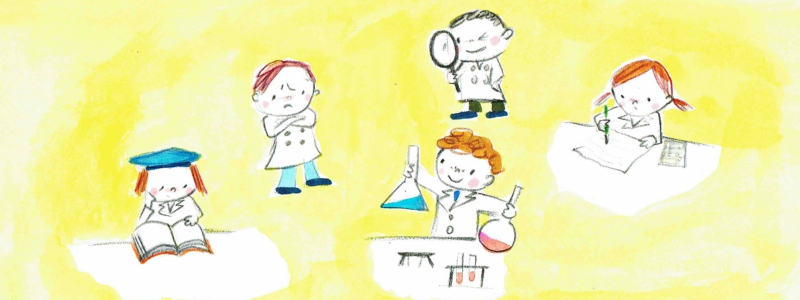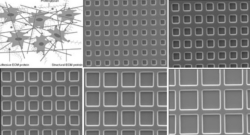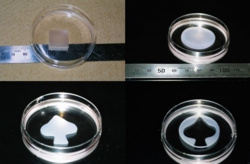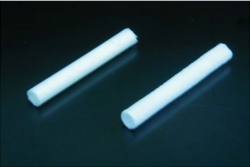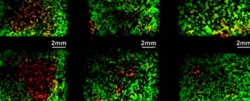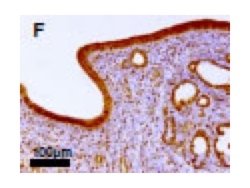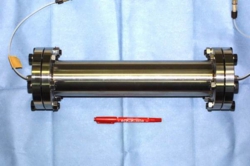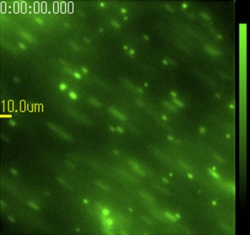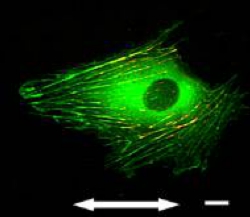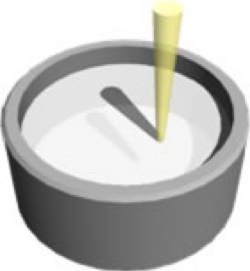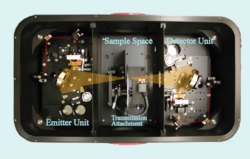Research Topic:
「Tissue engineering micro-nano patterns」
We are currently examining the effects on 3D micro-nano pattern structures on the behavioral control of stem cells. Especially in regards to differentiation, specific dimensions of micro-nano structures have been reported to induce osteoblastic differentiation of stem cells. The mechanism behind this phenomenon is due to the cell’s focal adhesion spots on the substrate, which in turn affects the internal cytoskeletal organization (i.e. actin and microtubules). The cytoskeleton is hypothesized to link to the nucleus and regulate differentiation.
Referece:
http://www.ncbi.nlm.nih.gov/pubmed/21360680
http://www.ncbi.nlm.nih.gov/pubmed/21925729
http://www.ncbi.nlm.nih.gov/pubmed/23219606
http://www.ncbi.nlm.nih.gov/pubmed/24342724
Research Topic:
Cartilage tissue engineering
For joint diseases such as osteoarthritis, there is accumulating expectations for tissue engineering to be used as the next-generation treatment option. In order to develop tissue engineered cartilage of large size with promising biological and mechanical properties, we are designing new cartilage models and devices that load mechanical stresses. Mechanical stimuli such as shear stress, hydrostatic pressure, and compressive forces have crucial roles in cartilage formation. A scaffold-free model developed by the laboratory enabled tissue growth in various different shapes when subjected to mechanical stress loading.
Referece:
http://www.ncbi.nlm.nih.gov/pubmed/25915185
http://www.ncbi.nlm.nih.gov/pubmed/25348678
http://www.ncbi.nlm.nih.gov/pubmed/24326098
http://www.ncbi.nlm.nih.gov/pubmed/24111344
http://www.ncbi.nlm.nih.gov/pubmed/19589126
http://www.ncbi.nlm.nih.gov/pubmed/18546028
http://www.ncbi.nlm.nih.gov/pubmed/18489244
http://www.ncbi.nlm.nih.gov/pubmed/18433308
http://www.ncbi.nlm.nih.gov/pubmed/17913274
http://www.ncbi.nlm.nih.gov/pubmed/17348796
http://www.ncbi.nlm.nih.gov/pubmed/17008763
http://www.ncbi.nlm.nih.gov/pubmed/12953921
http://www.ncbi.nlm.nih.gov/pubmed/12382679
Research Topic:
Vascular tissue engineering
It has been known that mechanical stimulation is effective for culturing tissue-engineered blood vessels. As such, we are currently developing bioreactors that can provide mechanical stimuli such as internal pressure and shear stress, and optimizing the parameters to achieve the best conditions for vascular tissue engineering.
Referece:
http://www.ncbi.nlm.nih.gov/pubmed/25915185
http://www.ncbi.nlm.nih.gov/pubmed/12382677
http://www.ncbi.nlm.nih.gov/pubmed/11549075
Research Topic:
Bone tissue engineering
Our laboratory focuses on the application of mechanical stimulation for bone tissue engineering. We are designing bioreactors that can mimic the native environment in providing flow and particle exchange to synthesize better bone tissues. Furthermore, by combining 3D fabrication technology with the bioreactors, we aim to replicate the complex structures of bone in vitro.
Referece:
http://www.ncbi.nlm.nih.gov/pubmed/25423088
http://www.ncbi.nlm.nih.gov/pubmed/25215543
http://www.ncbi.nlm.nih.gov/pubmed/24764314
http://www.ncbi.nlm.nih.gov/pubmed/23983180
http://www.ncbi.nlm.nih.gov/pubmed/19160373
http://www.ncbi.nlm.nih.gov/pubmed/19002585
http://www.ncbi.nlm.nih.gov/pubmed/18041721
Research Topic:
Uterus tissue engineering
We are currently challenging the reconstruction of uterus to solve sterility problems that occur with the loss of the native uterus. We have transplanted decellularized uterus scaffolds in rats with uterus loss and have succeed in the reconstruction of a better tissue.
Research Topic:
Development of novel bioreactors
We are developing various bioreactors for stimulating growth of tissue-engineered constructs mechanically. By using stimuli such as shear stress, hydrostatic pressure, stretch, ultrasound, compression, we are aiming to enhance tissue maturation to produce constructs with native-like mechanical properties.
Referece:
http://www.ncbi.nlm.nih.gov/pubmed/25915185
http://www.ncbi.nlm.nih.gov/pubmed/25348678
http://www.ncbi.nlm.nih.gov/pubmed/25215543
http://www.ncbi.nlm.nih.gov/pubmed/24764314
http://www.ncbi.nlm.nih.gov/pubmed/24111344
http://www.ncbi.nlm.nih.gov/pubmed/19589126
http://www.ncbi.nlm.nih.gov/pubmed/19160373
http://www.ncbi.nlm.nih.gov/pubmed/19002585
http://www.ncbi.nlm.nih.gov/pubmed/18546028
http://www.ncbi.nlm.nih.gov/pubmed/18489244
http://www.ncbi.nlm.nih.gov/pubmed/18433308
http://www.ncbi.nlm.nih.gov/pubmed/18041721
http://www.ncbi.nlm.nih.gov/pubmed/17913274
http://www.ncbi.nlm.nih.gov/pubmed/17348796
Research Topic:
Development of blood vessel simulator
In order to develop artificial organs with biocompatibility with blood, it is necessary to understand the dynamic environment that exists in the native blood vessels. We are developing a blood vessel simulator that is capable of simulating the various types of flow (pulsatile, quasi-static, laminar, turbulent, etc.) in the arteries and veins. By using less than 10μl of blood, we can analyze in real time the movements of particles in the blood (i.e. platelets) on various substrates.
Referece:
http://www.ncbi.nlm.nih.gov/pubmed/18485843
http://www.ncbi.nlm.nih.gov/pubmed/16819202
http://www.ncbi.nlm.nih.gov/pubmed/12828311
http://www.ncbi.nlm.nih.gov/pubmed/15967494
http://www.ncbi.nlm.nih.gov/pubmed/11110266
http://www.ncbi.nlm.nih.gov/pubmed/10357140
Research Topic:
Mechanotransduction
Recent researches have reveal the potency of mechanical stimulation on maintaining normal tissue function or suppressing disease onset. We are also aiming to elucidate the specific mechanisms to these phenomena using the bioreactors and real-time imaging systems developed in this lab.
Referece:
http://www.ncbi.nlm.nih.gov/pubmed/24326098
http://www.ncbi.nlm.nih.gov/pubmed/20060585
http://www.ncbi.nlm.nih.gov/pubmed/21689836
Research Topic:
3D fabrication technology
In tissue engineering, scaffolds are necessary in providing shape, structure and integrity for the cells and tissues. In our lab, we can developing novel 3D fabrication techniques using laser technology to synthesize complex scaffolds. We have successfully created scaffolds with nano-scale precision with this technology.
Referece:
https://onlinelibrary.wiley.com/doi/full/10.1002/adem.202300122![]() AdvEngMater2023.pdf(This achievement was partially supported by Keirin.)
AdvEngMater2023.pdf(This achievement was partially supported by Keirin.)
http://www.ncbi.nlm.nih.gov/pubmed/25215543
http://www.ncbi.nlm.nih.gov/pubmed/24764314
http://www.ncbi.nlm.nih.gov/pubmed/24384523
http://www.ncbi.nlm.nih.gov/pubmed/24111344
http://www.ncbi.nlm.nih.gov/pubmed/23983180
http://www.ncbi.nlm.nih.gov/pubmed/21550865
http://www.ncbi.nlm.nih.gov/pubmed/15120514
http://www.ncbi.nlm.nih.gov/pubmed/11549075
http://www.ncbi.nlm.nih.gov/pubmed/11549069
Research Topic:
Non-invasive assessment of tissue-engineered products via optical lasers
Since patients are all different, it is often desired to have tailor-made tissue engineering products to fit each individual patient. However, current assessment protocols often damages the tissues in the process (i.e. pulling and pressing to determine mechanical properties). In our lab, we are using laser technology to develop non-invasive assessment methods of tissue-engineered products.
